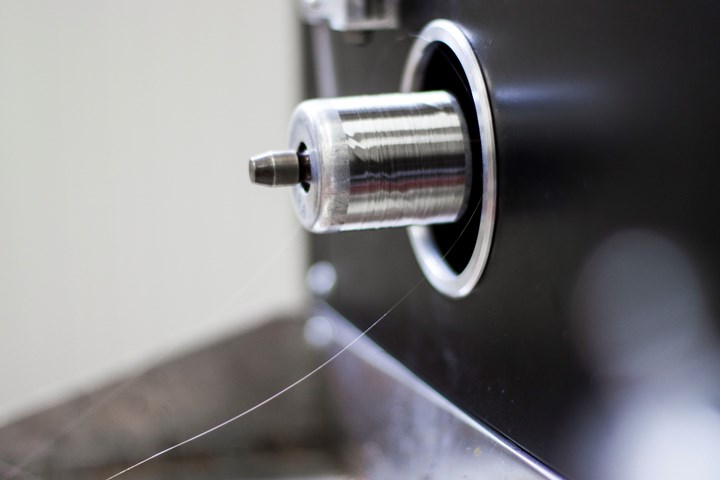Contact-less microsensor targets real-time NDT for composite structures
RVmagnetics’ MicroWire self-monitors composite structures via embedding during the production process. It improves safety, control and real-time data for predictive maintenance.

Photo Credit: RVmagnetics
RVmagnetics (Košice, Slovakia) has developed MicroWire — a miniaturized, magnetic, contact-less microsensor of physical quantities — that enables successful, real-time measurements for non-destructive testing (NDT) of composite-based structures. With the ability to sense temperature, pressure and magnetic field directly, and pull, axial stress, mechanical stress, torsion, bending, vibration, etc. indirectly, MicroWire is said to be a smarter self-monitoring product than conventional NDT methods.
Composed of composite materials itself, MicroWire consist of a metallic nucleus and glass coating. According to RVmagnetics, the microsensor is also a passive, unpowered element. To “power” it — enable sensing and obtain real-time live data — a set of coils (powered, active element) and electronics are placed within a 10-cm range, activating contact-less sensing. According to the company, without causing any material flows, or adding additional weight, MicroWire can be easily introduced into carbon fiber, glass fiber, ceramic, plastic composites and more via embedding between composite layers in the production process.
This embedding, says Rudolf Klein from RVmagnetics, will provide additional control, including control over each part of the production process (e.g. measure temperature locally not only on the surface but also in between the layers), random inspections and defect detections and real-time data about the current state of the composite (up to ten thousand times per second resolution) through the lifetime the composite is used.
The company notes that MicroWire provides an opportunity to create self-monitored composites, while reducing the likelihood of material failure, and optimization of the production process by minimizing material and production costs, and accelerating processes (composite decking, bonding, etc.) without risking cracks or other failures.
Further, combining AI with live data is said to increase safety, and provide data on remaining useful lifetime (RUL) for the structure. The financial gain, notes RVmagnetics, lays in reducing the frequency of maintenance tasks, transforming the reactive maintenance into predictive maintenance.
While current structural health monitoring methods are valuable in detecting and preventing potential damages in the production process or post-production RVmagnetics strives for safety, real-time measurements and industry transformation towards the digital. It is said that MicroWire sensing technology provides a gateway to real-time data from places that have been impossible to access thus far.
Related Content
-
Sulapac introduces Sulapac Flow 1.7 to replace PLA, ABS and PP in FDM, FGF
Available as filament and granules for extrusion, new wood composite matches properties yet is compostable, eliminates microplastics and reduces carbon footprint.
-
TU Munich develops cuboidal conformable tanks using carbon fiber composites for increased hydrogen storage
Flat tank enabling standard platform for BEV and FCEV uses thermoplastic and thermoset composites, overwrapped skeleton design in pursuit of 25% more H2 storage.
-
Plant tour: Albany Engineered Composites, Rochester, N.H., U.S.
Efficient, high-quality, well-controlled composites manufacturing at volume is the mantra for this 3D weaving specialist.
















